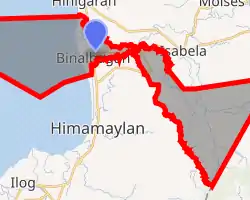Binalbagan
Binalbagan, officially the Municipality of Binalbagan (Hiligaynon: Banwa sang Binalbagan; Tagalog: Bayan ng Binalbagan), is a 1st class municipality in the province of Negros Occidental, Philippines. According to the 2015 census, it has a population of 67,270 people. [3]
Binalbagan | |
|---|---|
| Municipality of Binalbagan | |
 Binalbagan Municipal Hall | |
| Nickname(s): The True Heart of Negros | |
 Map of Negros Occidental with Binalbagan highlighted | |
OpenStreetMap 
| |
.svg.png.webp) Binalbagan Location within the Philippines | |
| Coordinates: 10°12′N 122°52′E | |
| Country | |
| Region | Western Visayas (Region VI) |
| Province | Negros Occidental |
| District | 5th District |
| Founded | May 15, 1572 |
| Barangays | 16 (see Barangays) |
| Government | |
| • Type | Sangguniang Bayan |
| • Mayor | Alejandro "Bebot" Y. Mirasol |
| • Vice Mayor | Ursecio Inodeo |
| • Representative | Maria Lourdes Arroyo-Lesaca |
| • Electorate | 43,656 voters (2019) |
| Area | |
| • Total | 189.96 km2 (73.34 sq mi) |
| Elevation | 5.0 m (16.4 ft) |
| Population | |
| • Total | 67,270 |
| • Density | 350/km2 (920/sq mi) |
| • Households | 14,823 |
| Economy | |
| • Income class | 1st municipal income class |
| • Poverty incidence | 21.65% (2015)[4] |
| • Revenue | ₱175,997,509.72 (2016) |
| Time zone | UTC+8 (PST) |
| ZIP code | 6107 |
| PSGC | |
| IDD : area code | +63 (0)34 |
| Climate type | tropical climate |
| Native languages | Hiligaynon Tagalog |
| Website | www |
Major economic activities include manufacturing, agriculture, services, cottage industries and tourism. Binalbagan is also known for the Binalbagan Isabela Sugar Company (BISCOM).
Binalbagan became a town on May 15, 1572[5] and was one of the first two settlements of Negros Occidental (the second being the municipality of Ilog). On the record, Binalbagan is the oldest town in the whole Negros Island, thereby earning the title, “Banwang Panganay” or oldest town.
The municipality celebrates an annual fiesta called "The Balbagan Festival" every month of May.
Barangays
Binalbagan is politically subdivided into 16 barangays: thirteen (13) rural barangays and three (3) urban barangays.[6]
Urban Barangays
- Pagla-um
- San Pedro
- Santo Rosario
Rural Barangays
- Amontay
- Bagroy
- Bi-ao
- Canmoros
- Enclaro
- Marina
- Payao (formerly Soledad)[7]
- Progreso
- San Jose
- San Juan
- San Teodoro
- San Vicente
- Santol
- Remedios
Climate
| Climate data for Binalbagan, Negros Occidental | |||||||||||||
|---|---|---|---|---|---|---|---|---|---|---|---|---|---|
| Month | Jan | Feb | Mar | Apr | May | Jun | Jul | Aug | Sep | Oct | Nov | Dec | Year |
| Average high °C (°F) | 30 (86) |
31 (88) |
32 (90) |
33 (91) |
32 (90) |
30 (86) |
29 (84) |
29 (84) |
29 (84) |
29 (84) |
30 (86) |
30 (86) |
30 (87) |
| Average low °C (°F) | 22 (72) |
22 (72) |
22 (72) |
24 (75) |
25 (77) |
25 (77) |
25 (77) |
25 (77) |
24 (75) |
24 (75) |
23 (73) |
23 (73) |
24 (75) |
| Average precipitation mm (inches) | 38 (1.5) |
29 (1.1) |
55 (2.2) |
65 (2.6) |
141 (5.6) |
210 (8.3) |
212 (8.3) |
176 (6.9) |
180 (7.1) |
180 (7.1) |
130 (5.1) |
70 (2.8) |
1,486 (58.6) |
| Average rainy days | 9.0 | 7.2 | 11.1 | 13.5 | 25.6 | 28.4 | 28.9 | 27.3 | 26.9 | 27.7 | 21.8 | 13.8 | 241.2 |
| Source: Meteoblue [8] | |||||||||||||
Demographics

|
| ||||||||||||||||||||||||||||||||||||||||||||||||
| Source: Philippine Statistics Authority [3] [9] [10][11] | |||||||||||||||||||||||||||||||||||||||||||||||||
The people in the city speak the Hiligaynon language (often called Ilonggo). Filipino and English are generally understood.
Education
- Tertiary
- Binalbagan Catholic College
- Carlos Hilado Memorial State College (formerly Negros Occidental School of Fisheries)
- Southern Negros College
- Dynatech Industrial Institute
Notable people
- Jose Miguel Tuason Arroyo (first gentleman of former Philippine President, Gloria Macapagal Arroyo)
- Ignacio "Iggy" Tuason Arroyo, Jr. (member of the Philippine House of Representatives)
- Augurio Abeto (dubbed as the "King of Hiligaynon Poetry")
- Ian Clark Bautista (Southeast Asian Games Boxing Gold Medalist)
- Rico Amancio (Masterchef Asia Contestant)
References
- Municipality of Binalbagan | (DILG)
- "Province:". PSGC Interactive. Quezon City, Philippines: Philippine Statistics Authority. Retrieved 12 November 2016.
- Census of Population (2015). "Region VI (Western Visayas)". Total Population by Province, City, Municipality and Barangay. PSA. Retrieved 20 June 2016.
- "PSA releases the 2015 Municipal and City Level Poverty Estimates". Quezon City, Philippines. Retrieved 12 October 2019.
- "The Official Website of Binalbagan". Retrieved 2012-05-20.
- "Archived copy". Archived from the original on 2015-01-01. Retrieved 2015-01-01.CS1 maint: archived copy as title (link)
- "An Act Changing the Name of Barrio Soledad in the Municipality of Binalbagan, Province of Negros Occidental, to Barrio Payao". LawPH.com. Retrieved 2011-04-12.
- "Binalbagan: Average Temperatures and Rainfall". Meteoblue. Retrieved 7 May 2020.
- Census of Population and Housing (2010). "Region VI (Western Visayas)". Total Population by Province, City, Municipality and Barangay. NSO. Retrieved 29 June 2016.
- Censuses of Population (1903–2007). "Region VI (Western Visayas)". Table 1. Population Enumerated in Various Censuses by Province/Highly Urbanized City: 1903 to 2007. NSO.
- "Province of". Municipality Population Data. Local Water Utilities Administration Research Division. Retrieved 17 December 2016.
